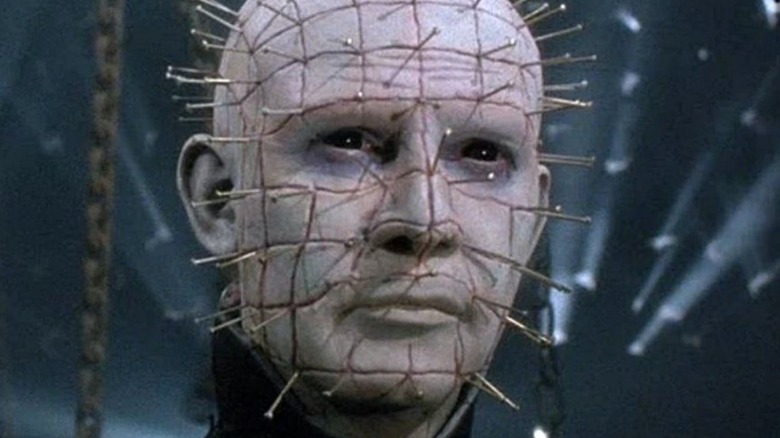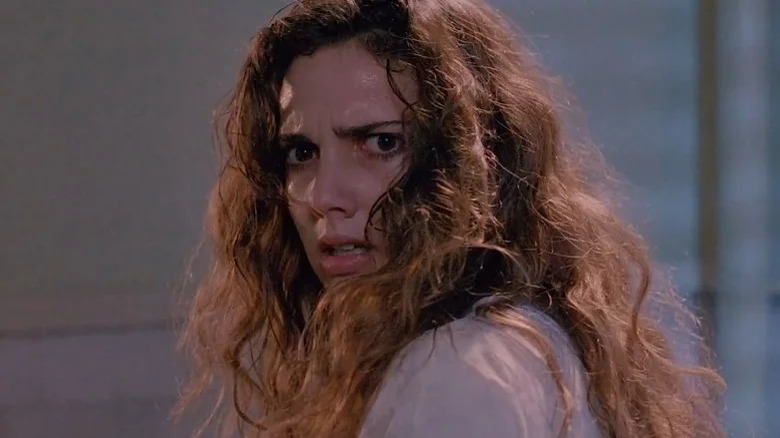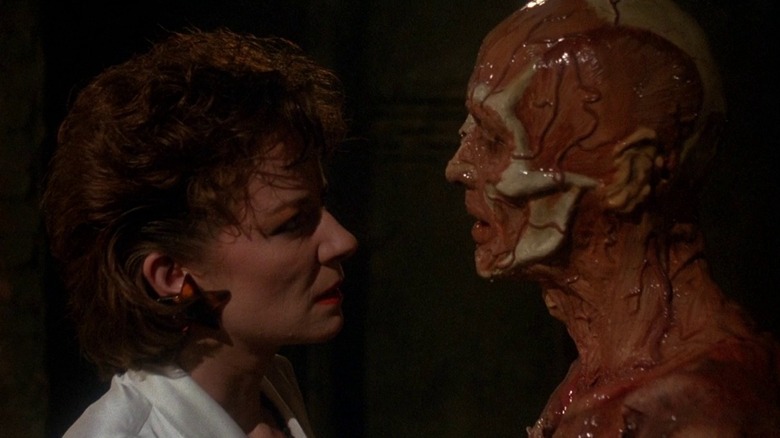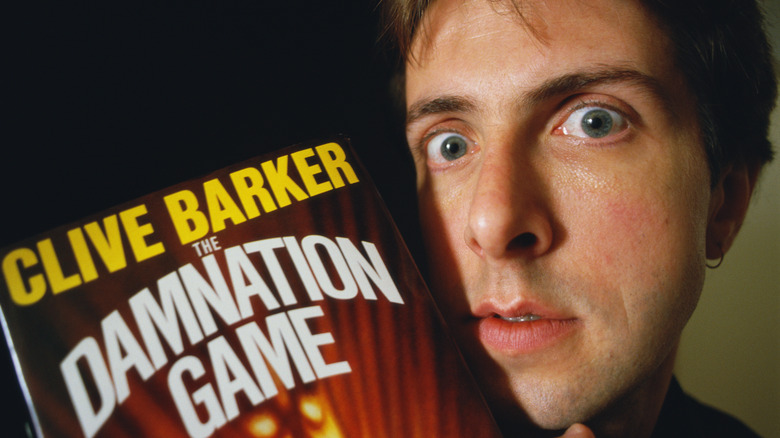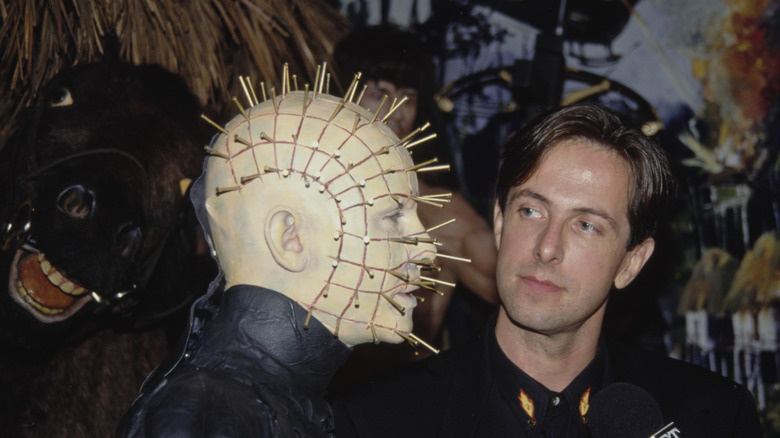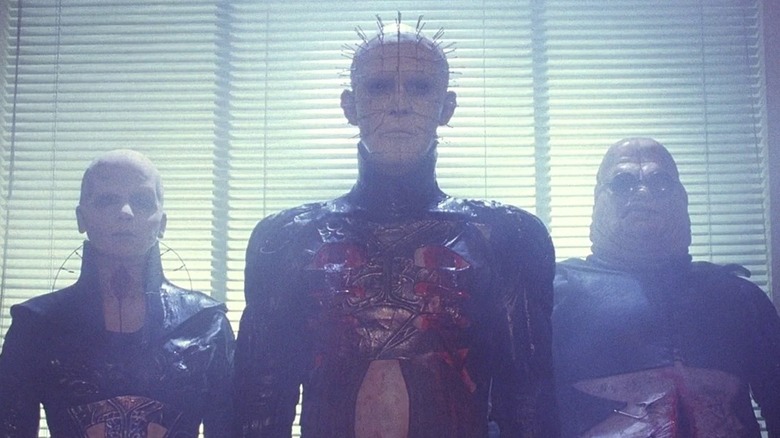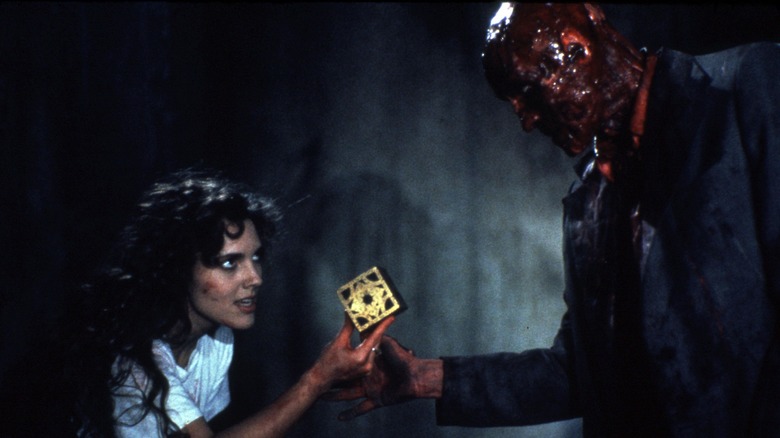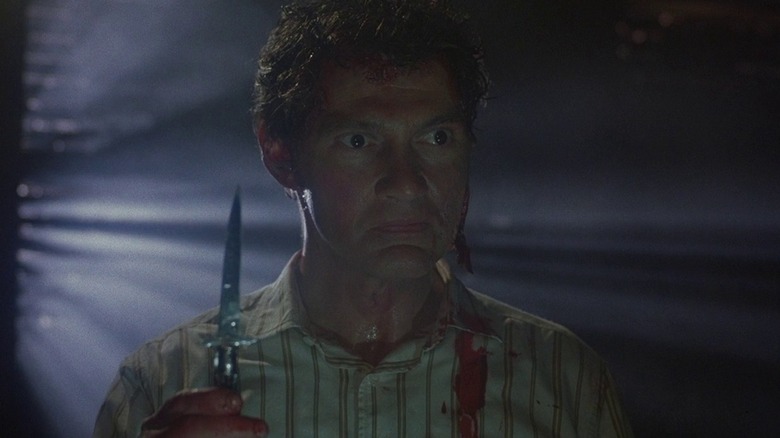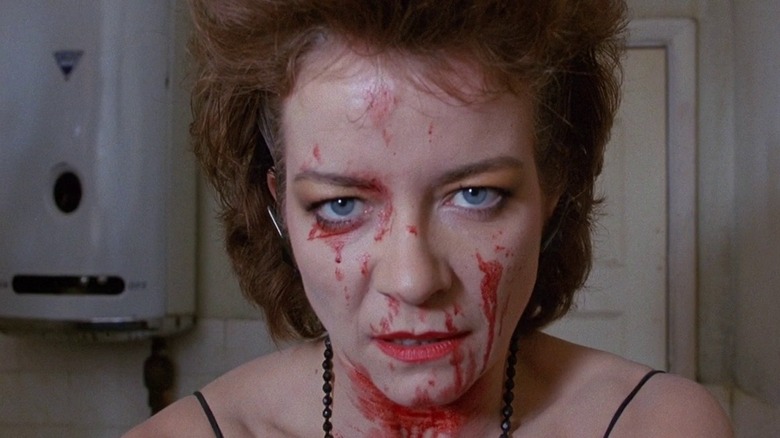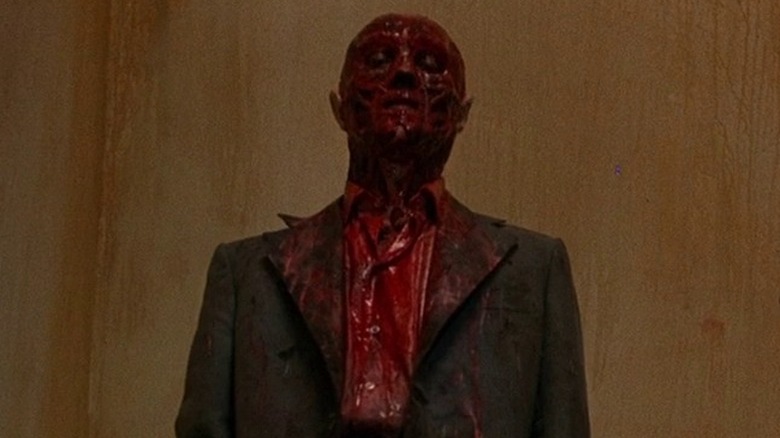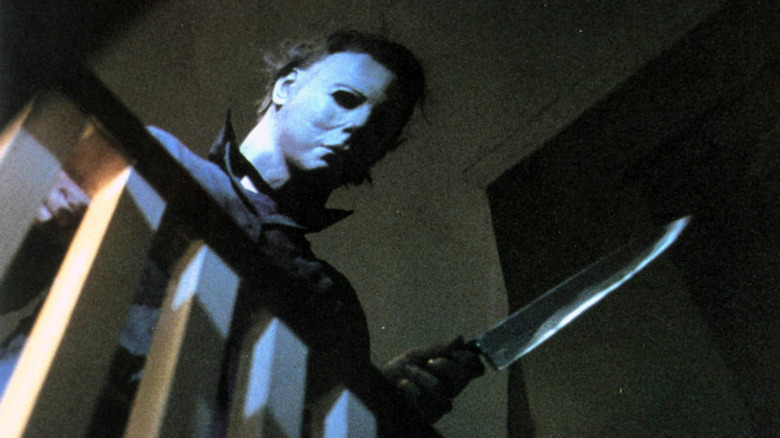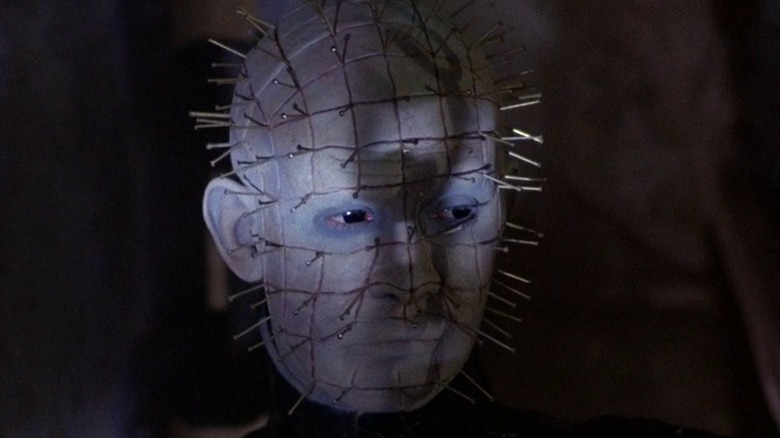The Untold Truth Of Hellraiser
When "Hellraiser" hit the big screen in 1987, it wasn't everybody's cup of gore. Released in a decade that favored teen slasher flicks, the twisted love story involving skinned adulterers and sadomasochists from other dimensions did things a little differently. Its horrors were both cerebral and physical, and it contained just the right mix of eroticism, mysticism, and terror to leave the audience wanting more of the same. In many ways, it marked the turning of a tide and a return to a more sophisticated form of horror. Watch it today and you'll notice how well it's aged — the plot still captivates, the performances still stand, the pace is relentless, and the Cenobites are still genuinely scary in their watchful and patient stillness.
Much of the film's modern feel resides with the keen eye of Bob Keen, who was responsible for the make-up of the flayed Frank and the Cenobites (per Daily Dead). Yet it also helped that "Hellraiser" gave birth to a timeless and unique villain in the shape of Pinhead (Doug Bradley), whose haunting personality reminded viewers how complex and captivating a villain could be. However, the film's greatest strength was its writer and director Clive Barker. Authors don't often get the chance to direct adaptations of their own work, but Barker seized the wheel and steered the film to such success that nine sequels and a reboot followed in its wake.
Just how did this horror landmark come to be? As Pinhead once said, "We have such sights to show you!"
Hellraiser was nearly called Sadomasochists From Beyond the Grave
What's in a name? Well, quite a lot when it comes to a movie. Just imagine if "Toy Story" had been called "Toyz in the Hood," "Alien" had been called "Star Beast," "Blade Runner" had been entitled "Do Androids Dream of Electric Sheep," or "Back to the Future" had been promoted under the name "Spaceman from Pluto" (all real examples, per The Independent)? Would these films still have gone on to be box-office smashes and critical faves? We'll never know. But what we do know is that "Hellraiser" was very nearly called "Sadomasochists From Beyond the Grave."
According to Clive Barker's official site, Revelations, the author explained in an interview with Fangoria in 1987 that he originally wanted "Hellraiser" to have a very different title. He revealed, "The imagery we're employing is, as far as the creatures from hell are concerned, something that hasn't been done before. They're like sadomasochists from beyond the grave. In fact, that's what I originally wanted to call the picture." As titles go it's certainly a bit beyond the pale, and a lot different from "The Hellbound Heart," the title of the novella that inspired the film. Still, if there ever was to be a gang name that nailed the vibe that Pinhead, Butterball, and the rest of the cenobites give off, "Sadomasochists From Beyond the Grave" is spot on.
Wipe away the gore and Hellraiser is a simple love story
On one level, "Hellraiser" is a cautionary horror story about what happens to a curious individual when he begins to meddle in the supernatural and ends up accidentally summoning the most unwanted guests in history. In another sense, behind the flesh flaying, the screams, the carnage, and the sadist with pins in his face, there is what Clive Barker called in an interview with Monsterland "a love story from beyond the grave." It may sound absurd, but scratch the surface and you'll see Barker is not wrong. The author explained that just as it's desire that leads Frank Cotton (Sean Chapman) to a lonely place where he's skinned alive, it's the same desire that leads his brother's wife, Julia Cotton (Clare Higgins), down the road to ruin.
Julia attempts to resurrect her old lover by butchering unsuspecting men so Frank can feed on their precious life energies, but as Barker points out, she doesn't do it because she's a psychopath — she does it for love. Barker stresses in the same interview that in "Hellraiser" he wanted to create an "intelligent and popular horror movie" that was not a generic slasher flick that exploits women or manipulates sensibilities. "There has been a general move towards the infantile in horror pictures recently, a desire to soften the blows," Barker added. "I hope this time we're going to get tough again."
Hellraiser was author Clive Barker's first directorial rodeo
Having only made a couple of short films with a group of friends in Liverpool as a teenager, "Hellraiser" was Clive Barker's first experience helming a major movie production. Directing a feature film for the first time was daunting, as he revealed in a YouTube video. "I didn't know the rules. I didn't know who the sound guy was. I only knew who the camera operator was because he was the guy behind the camera," Barker recalled. He added, "I don't think that finally hurt the movie. May have actually been useful because I sort of made it up as I went along."
Barker explained in the same interview, "I've always loved the film. I've always enjoyed the movie-going experience." When he was young, he and a group of friends who shared his passion grabbed an 8mm camera and shot two shorts, "Salome" and "The Forbidden." The films were inspired by underground and experimental directors such as Kenneth Anger. Coincidentally, Doug Bradley (who would go on to play Pinhead) and Pete Atkins (who would later write "Hellbound: Hellraiser II," "Hellraiser III: Hell on Earth," and "Hellraiser: Bloodline") were involved in the production of "Salome" and "The Forbidden."
"They are technically extremely crude and their storylines obscure," Barker has said of the shorts (per The Clive Barker Archive). "Actually I think it has a strange poetry about it." That "strange poetry" and the themes of pacts, rituals, murderers, and sexuality did have a bearing on "Hellraiser" — particularly the scene where Frank is skinned.
Clive Barker hated the name Pinhead
Alongside Leatherface, Michael Myers, Freddy Krueger, and Pennywise, Pinhead is an almost universally recognizable villain and an iconic embodiment of '80s horror. It might be surprising, then, that in the first "Hellraiser" film, he's not technically a bad guy — just a representative of hell who takes his job very seriously, with the look of someone from the wrong side of the tracks. But according to his creator, the moniker Pinhead does not do the character justice. Clive Barker explained in an interview with Dread Central that the character was a priest of hell who was nameless in the original script. However, a special effects artist referred to him as "Pinhead," and that was that. Barker recalled, "I was like, 'Wait a second, you just named my villain Pinhead?' I didn't think that sounded very dignified. But it ended up on the call sheet, and it just stuck."
Before the release of "Hellraiser," no one realized how popular the guy with pins in his face would end up being. The hell priest was not even the original poster boy for the film, according to an interview Doug Bradley gave to HorrorOnline.com in 1999. The Pinhead actor explained that a flayed Frank was originally the image intended to promote the film. At some point during production, the powers that be opted for the peculiar guy holding a peculiar box to push the film into the darkest corners of the public consciousness. Bradley explained, "The image is so original, so startling. It is just an incredible image to look at, and that made a big difference in terms of the public's perception of the movie."
S&M clubs had a big influence on the Cenobites' image
Let's be honest — the Cenobites are a pretty eye-catching bunch. If Pinhead and his posse strutted into a party it would certainly create a stir. Their look is hellish, and with all the leather and boots it's reminiscent of the weirdest shock rock group never to play a gig. You wouldn't want to bump into these guys in a graveyard or an S&M club, which according to Clive Barker is where the inspiration from the Cenobites' distinctive look came from. Barker told The Guardian that both the physical and emotional make-up of the Cenobites was inspired by S&M clubs he had frequented, specifically an underground club in New York called Cellblock 28.
Barker revealed that Cellblock 28 had a very hardcore S&M night where there was no drinking or drugs, just intense pain, pleasure, and a lot of piercings. "It was the first time I ever saw people pierced for fun," Barker recalled. "It was the first time I saw blood spilled. The austere atmosphere definitely informed Pinhead: 'No tears, please. It's a waste of good suffering.'" Barker explained that the move to make the Cenobites act and dress a certain way was met with a positive reception from the S&M community. "I was validating a lifestyle," he said. "It was a celebration of the beauty of these strange secret rituals."
Clive Barkers's grandfather was an integral inspiration for Hellraiser
The puzzle box in "Hellraiser" with which Frank opens the doors to another dimension is integral to the film's plot. The peculiar-looking device — also known as the Lament Configuration (via scarystudies.com) — was described in "The Hellbound Heart' as one of several in existence that was created by Frenchman Philip LeMarchand. One is said to be safely under lock and key in the basement of the Vatican, another was rumored to have been in the possession of the Marquis De Sade during his tenure at the Bastille, and a third found its way into the hands of an Englishman named Frank. The inspiration for the puzzle box which allows passage between realities was inspired by an unlikely source: Clive Barker's grandfather.
According to an interview with the podcast The Geek's Guide To The Galaxy, Barker wanted his protagonist to access hell by other means than the more traditional routes of a magical circle surrounded by symbols. He was eventually drawn to a childhood memory of an elaborate and carved wooden puzzle box his grandfather, who was a ship's cook, brought back from the Far East. Barker recalled playing with the box a lot as a child. When he was puzzling about how best his character in "The Hellbound Heart" could open the doors of Hell, he remembered his grandfather's box and the final part of the jigsaw fell into place.
Roger Ebert hated Hellraiser with a passion
Although many praised "Hellraiser" upon its release for breathing new life into the horror genre and adding a little Shakespearian gravitas to the standard bloodfest, not everyone was won over by Clive Barker's vision for the future of horror. Famed film critic Roger Ebert gave it a paltry half-star review, slamming it as a dreary sham. He wrote, somewhat viciously, "This is one of those movies you sit through with mounting dread, as the fear grows inside of you that it will turn out to be feature-length." If that seems a tad harsh, it gets worse — Ebert went on to question the motives of the audience for going to see the movie. In his opinion, "Hellraiser" contained no surprises or emotional engagement, and lacked any wit or flair. Try telling that to Pinhead.
Interestingly, Ebert's harsh verdict on the film appeared to be the opening shot in a war of words between the legendary critic and Clive Barker, as chronicled on Ebert's own site. Years after the release of "Hellraiser," Barker would slam the critic for a controversial statement: "Video games can never be art." Barker described Ebert as "prejudiced," calling him a "pompous, arrogant old man." How much bearing Ebert's notorious review of "Hellraiser" had on Barker's scathing words we'll never know, but just as criticism is always subjective, an artist never forgets a bad review.
The original Hellraiser soundtrack was canceled
It's no good sweating buckets to create a horror film designed to shock and unnerve the audience if you pay scant attention to the soundtrack. Music adds ambience, atmosphere, suspense, and dread to a movie. In short, the likes of Pinhead cannot share screen time with a Disneyesque soundtrack — it would be terribly unbecoming. Before its release, industrial heavy-hitters Coil delivered a sonically charged hellscape of a soundtrack to accompany Clive Barker's film. However, it never made the final cut and was replaced by Christopher Young's more traditional score (via Treble).
Barker was friendly with members of Coil, and felt their unique sound would make a perfect fit for "Hellraiser." The studio disagreed, apparently deciding that the soundtrack was just too damned unsettling. Anyone familiar with Coil's work during that period wouldn't have been surprised — as Barker himself once said, "Coil is the only group I've heard on disc, whose records I've taken off because they make my bowels churn." Yet the truth as to why Coil's soundtrack was never given the green light is rather more pedestrian. Coil's Stephen Thrower told The Quietus that when Barker asked the producers for more special effects funding, they said something along the lines of, "Oh we didn't think this was going to be as commercial as it is. Re-shoot those effects scenes and here's some more money. One stipulation, we want our man to do the score."
Hellraiser had someone on set specifically to look after the cockroaches
Much like busy kitchens, movie sets are hectic places. Everyone's got a job to do and everyone's rushing out frantically, trying not to get in one another's way. Costume designers, camera operators, production managers, and boom operators, all playing their part in a bid to keep things from boiling over. On the set of "Hellraiser," they also had their very own maggot and cockroach wrangler to keep things in order. It was an odd job, but a necessary one in a pre-CGI age when everyone had to get their hands dirty to create something authentic. In an interview with Film Threat, Clive Barker pointed out that being on a movie set from six in the morning to eight at night and dealing with 30 diverse people, all with equally important jobs to do, was far more tiring than he had first anticipated, but relief came with the cockroach scenes.
"The moments which were really exciting were the major cockroach scenes, which I really liked," Barker enthused. "We had a roach-wrangler. We had Tupperware, you know? The ultimate Tupperware container — your Roach Tupperware Container — in the fridge." Barker explained that they had special passports and visas to import big, fat American cockroaches to the UK. They could only import male cockroaches because there was a danger they could escape and procreate. Barker reflected, "Somewhere in customs there's presumably a roach sexer!"
There could have been a Hellraiser vs. Halloween movie
Imagine Pinhead and Michael Myers battling it out for supremacy in a cinematic crossover along the lines of "Freddy vs. Jason" or "Alien vs. Predator" ... and then imagine it some more because it's probably never going to happen. However, it nearly did. Although it probably wouldn't have contained a lot of small talk between the chief Cenobite and the masked murderer, it was a promising premise nevertheless. Paul Kane's book, "The Hellraiser Films and Their Legacy," reveals that filmmaker Dave Parker once pitched the idea of a crossover involving Pinhead and Michael Myers to Dimension Films.
Parker needed an idea to get the two villains together for a rumble, so he hatched an origin story that would open with a flashback in which Myers is trick-or-treating as a child and receives a mysterious box from a stranger in black boots. Upon opening it, the Lord of the Dead possesses Myers' body and goes on a killing spree. Because he's possessed by a demonic entity, Myers cannot be killed until Pinhead shows up years later, and it's game on.
Dimension was excited enough to reach out to both Clive Barker and John Carpenter and pencil in a movie release date of October 31, 2004 (via CliveBarkerCast). However, not only did the owners of the "Halloween" movie rights throw shade on the idea, a poll on the official "Halloween" website suggested that the majority of fans didn't want the movie to happen ... and so it didn't.
Doug Bradley feared he would be unrecognizable as Pinhead
One of the most unsettling things about the cenobites — apart from their insatiable desire to inflict pain and their otherwise questionable ethics — is their unnerving silence. Unwavering eye contact with unreadable yet intense facial expressions, combined with the art of keeping your entire body extremely still, is the embodiment of psychological intimidation. The cenobites are obvious masters at it. Except for Pinhead, who's not exactly mister chatterbox, the rest of the cenobites in "Hellraiser" are a pretty mute bunch. In total, Pinhead is only in the film for eight minutes and doesn't have a lot of lines, so it's no wonder that combined with the industrial make-up, Doug Bradley thought he would be unrecognizable as the chief villain of "Hellraiser."
In an interview with The Guardian, Bradley explained that he was offered both the role of Pinhead and the bit part of a moving man. He had reservations about playing a heavily made-up monster. "Because 'Hellraiser' was my first movie, I thought it might be a good idea to be on screen as myself," the actor recalled. "But it was a brief conversation. There was no doubt in my mind that this unnamed guy with the pins in his head had a certain je ne sais quoi that a mattress-delivery guy didn't." The first time he saw himself in the mirror as Pinhead, Bradley knew he had made the right decision. "I had a sense of majesty. His threat is implied: Look what I did to myself — now imagine what I can do to you."
